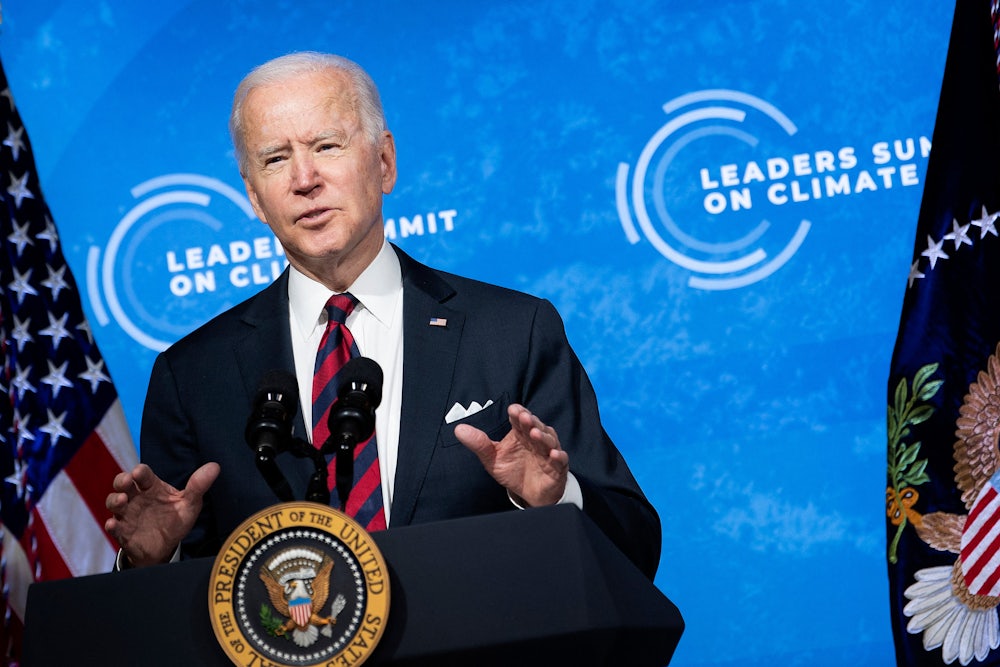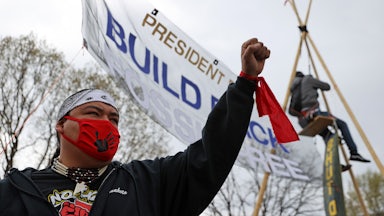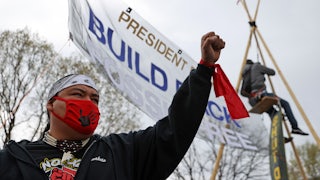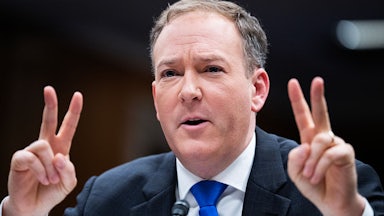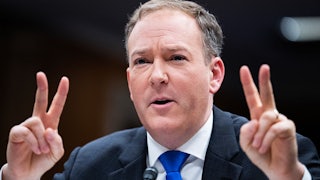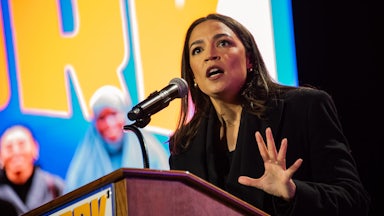There’s a troubling pattern in coverage of the White House’s new emissions target, formally announced Thursday morning as part of an international climate summit. On its face, the Biden administration’s pledge to cut emissions to 50 to 52 percent of 2005 levels by 2030 would seem to herald a groundbreaking shift in climate policy in the United States: After four years in the wilderness under Donald Trump, the U.S. leadership that engineered the Paris Agreement is back on top, “cutting greenhouse gas emissions in half,” as the New York Times headline put it. Is today’s announcement really so historic?
Establishing a 2030 target is important. But it’s also a basic requirement for the U.S. reentering the Paris Agreement as established in 2015 by signatories to the U.N. Framework Conventions on Climate Change; the 26 to 28 percent by 2025 “nationally determined contribution” pledged by the Obama administration needed to be updated for the U.S. to remain in basic compliance. That fact isn’t mentioned in either The Washington Post’s or CNN’s reporting, nor in the Politico piece that first reported the “ambitious” planned target earlier this week. And the target itself is lower than it appears. The UNFCCC’s own standard baseline for judging reductions is against 1990 emissions levels, not those from 2005. That means the pledge is in reality a much more modest 43 percent reduction by 2030, the Times notes. Currently, the U.S. is on track to reduce emissions by just 12 percent below 2005 levels by 2030, according to the research firm Energy Innovation.
While outlets have reported countries being skeptical that the U.S., which reneged on both the Kyoto Protocol and Paris Agreement, can be a reliable actor on climate, little of the mainstream coverage has mentioned the fact that the targets already in place don’t add up to much. In late February, the UNFCCC issued a report tallying new and updated commitments, accounting for 75 of the 191 nations signed on to the Paris Agreement, and excluding the U.S. and China. They found that fulfilling these targets would see global emissions decrease by just 1 percent below 2010 levels—a very, very far cry from the 45 percent global reductions needed over the next decade. As U.N. Secretary-General António Guterres put it, “Governments are nowhere close to the level of ambition needed to limit climate change to 1.5 degrees and meet the goals of the Paris Agreement.”
It’s still unclear how the U.S. would meet even its new pledge, congressional obstructionism being what it is, and given the Biden administration’s reluctance so far to tackle fossil fuel production head-on. And even the “50 percent” by 2030 goal is also far lower than what civil society groups say is the bare minimum for an equitable emissions-reduction plan. The IPCC outlines that the world will need to hit net-zero by 2050 to meet the Paris Agreement’s goals.
Even putting aside the questionable merits of “net-zero” commitments, getting there should leave space for other countries to develop, still a carbon-intensive process. The U.S. should accordingly bring down its own emissions much, much faster, while putting its considerable resources to work making a transition off fossil fuels possible for parts of the world still inordinately reliant on coal. That’s not singly a U.S. responsibility, of course. Given its historical responsibility for the crisis, though, showing a good-faith commitment on climate finance has to go beyond the hodgepodge of niche charity efforts Antony Blinken listed in his climate speech earlier this week. The White House provided few details on its intentions beyond pressuring other countries to do more. A number of global nongovernmental organizations have laid out what they called a Fair Shares Nationally Determined Contribution as a guide: To account for its historic and current role in climate change, the Fair Shares NDC stipulates, the U.S. would ideally cut its own emissions by 70 percent by 2030, and enable 125 percent reductions abroad through financing commitments on mitigation, adaptation, and recovery efforts. The recommendation proposes $800 billion as a “good faith down payment toward the U.S. fair share of international climate finance.”
The Biden administration’s talking points on climate have emphasized the tremendous business and job-creating opportunities of taking on climate change. These are also virtually indistinguishable from those out of the Chamber of Commerce, which represents some of the country’s biggest polluting companies, which would like to have their earth-shaped cake and eat it, too—ideally with lower taxes. “U.S. businesses are leading the world in pursuit of climate change solutions, and we see great opportunities to develop and export technologies that will help address a truly global challenge,” the business lobby wrote in a statement responding to Biden’s pledge. A collection of major businesses—including several majorly polluting electric utilities, and companies that fuel extraction—recently called for a target identical to the one Biden announced. The American Petroleum Institute issued a broadly supportive statement, too, albeit recommending a carbon price. If some of the world’s biggest contributors to global warming can get behind a supposedly ambitious pledge, how ambitious can it really be?
Journalists tend to evaluate climate announcements in relative terms: against those that came before them and those happening elsewhere. In that sense, today’s announcement is indeed a very big deal. But it also doesn’t come with a rigorous enforcement mechanism, or a guaranteed plan to actually reach the targets. And judged against the scale of what’s needed, it’s peanuts.
